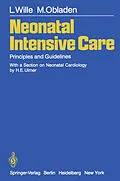1. Practical Management of High-Risk Newborns.- Evaluation and Treatment of the Newborn Immediately After Birth.- 1.1 Predisposing Risk Factors.- 1.2 Diagnosis of Postpartum Condition.- 1.3 Classification of Asphyxia.- 1.4 Primary Care and Resuscitation.- 1.5 Assessment of Gestational Age.- 1.5.1 Definitions.- 1.5.2 Requirements for Assessment of Gestational Age.- 1.5.3 Criteria for Assessment of Gestational Age.- 1.6 Intrauterine Growth Curves.- 1.7 Differentiation Between Preterm and Small-for-Gestational-Age Infants.- 1.8 Determining the Stage of Dysmaturity.- 1.9 Main Symptoms During the First Days of Life.- 1.1 References.- 2 Transport of High-Risk Newborns.- 2.1 Indications for Transfer.- 2.2 Informations Prior to Transport.- 2.3 Organization and Conduct of the Transport.- 2.4 Equipment of a Mobile Intensive Care Unit.- 2.5 Contents of the Emergency Kit.- 2.6 Measures Following Transport.- 2.2 References.- 3 Patient Supervision.- 3.1 Pulse and Heart Rate.- 3.2 Variance of the Heart Rate.- 3.3 Respiration.- 3.4 Temperature.- 3.4.1 Servocontrol.- 3.4.2 Temperature Monitoring.- 3.4.3 Intermittent Manual Measurement.- 3.4.4 Incubator Temperature.- 3.5 Blood Pressure.- 3.5.1 Flush Method.- 3.5.2 Detection of Pulse Waves or Vascular Movements with Ultrasound.- 3.5.3 Direct Measurement.- 3.6 Central Venous Pressure.- 3.6.1 Umbilical Vein Catheter.- 3.6.2 Continuous Measurement with Electronic Pressure Transducer.- 3.7 Computer-Assisted Patient Monitoring.- 3.3 References.- 4 Nutrition During the First Days of Life.- 4.1 General.- 4.2 Oral Feeding.- 4.2.1 Healthy Term Infants.- 4.2.2 Preterm Infants.- 4.2.3 Small-for-Gestational-Age Infants.- 4.2.4 Sick Infants.- 4.3 Nasojejunal Feeding.- 4.4 Supplementary Intravenous Feeding.- 4.5 Total Parenteral Nutrition.- 4.4 References.- II. Diagnosis and Treatment of Respiratory Disorders.- 5 Blood Gas Analysis.- 5.1 Measuring Techniques.- 5.1.1 Direct Measurement with Sensitive Electrodes (e. g., Corning, AVL).- 5.1.2 Indirect Measurement.- 5.1.3 Criteria for Selecting a Blood Gas Analyzer.- 5.2 Transcutaneous Oxygen Measurement.- 5.3 Collection of Blood Samples.- 5.3.1 Capillary Sampling.- 5.3.2 Warmed Capillary Sampling.- 5.3.3 Arterial Puncture.- 5.3.4 Umbilical Artery Catheter.- 5.3.5 Indwelling Catheter in Radial or Temporal Artery.- 5.4 Interpretation.- 5.5 Blood Gas Analysis: Normal Values in the Newborn.- 5.6 Disturbances of the Acid-Base Balance.- 5.7 Medicinal Treatment of Acid-Base Disturbances.- 5.7.1 Indications.- 5.7.2 Dosage.- 5.7.3 Administration.- References.- 6 Oxygen Therapy.- 6.1 Indication.- 6.2 Hypoxia Diagnosis, Hyperoxia Test.- 6.2.1 Indication for Artificial Ventilation.- 6.2.2 Differential Diagnosis of Congenital Heart Defects.- 6.3 Oxygen Dissociation.- 6.4 Causes of Disturbances in Oxygenation.- 6.4.1 Impaired Ventilation.- 6.4.2 Impaired Diffusion.- 6.4.3 Impaired Perfusion.- 6.4.4 Disturbances of Oxygen Binding and Oxygen Transport.- 6.5 Dosage of Oxygen in Respiratory Gas.- 6.5.1 PaO2 Measurement.- 6.5.2 tcPO2 Measurement.- 6.6 Modes of Administration.- 6.6.1 Incubator.- 6.6.2 Plastic Head Box (Oxyhood).- 6.6.3 Ventilation.- 6.7 Side Effects of Oxygen Therapy.- 6.7.1 Retrolental Fibroplasia.- 6.7.2 Bronchopulmonary Dysplasia.- 6.7.3 Ventilatory Depression.- References.- 7 Artificial Ventilation M. Obladen.- 7.1 Ventilatory Status of the Newborn.- 7.2 Indication for Artificial Ventilation.- 7.2.1 Birth Asphyxia or Emergency.- 7.2.2 Central Respiratory Disturbance and Immaturity.- 7.2.3 Respiratory Distress Syndrome.- 7.2.4 Aspiration Syndrome.- 7.2.5 Cardiac Failure.- 7.3 Technical Essentials.- 7.3.1 Disinfection of Tubing and Equipment.- 7.3.2 Assembly of Ventilator Tubing.- 7.4 Ventilators and Their Operation.- 7.4.1 Classification of Some Ventilators Suitable for Neonatal Use.- 7.4.2 Bird Mark.- 7.4.3 Bourns LS 104-150.- 7.4.4 Bourns BP 200.- 7.4.5 Cavitron PV 10, Biomed MVP 10.- 7.4.6 Ventilator Test Run.- 7.4.7 Basic Settings of a Neonatal Ventilator Ready for Use.- 7.4.8 Intermittent Mandatory Ventilation (IMV).- 7.5 Continuous Positive Airway Pressure (CPAP).- 7.5.1 Definitions.- 7.5.2 Principle.- 7.5.3 CPAP System.- 7.5.4 CNP System (Pulmarca).- 7.5.5 Comparison of CNP and CPAP.- 7.5.6 Complications and Side Effects of CPAP.- 7.6 Control of Ventilation.- 7.6.1 Control Scheme.- 7.6.2 Changing the Ventilator Settings.- 7.7 Examples of Ventilation.- 7.7.1 Immature Preterm Infant with Apneic Attacks and Central Respiratory Disturbance.- 7.7.2 Preterm Infant, Stage-II RDS, Stabilization by Prolonged Inspiration.- 7.7.3 Preterm Infant, Stage-III RDS, Weaning by Use of IMV.- 7.7.4 Child of Diabetic Mother, Stage-IV RDS, Stabilization by High Inspiratory Pressure.- 7.7.5 Heart Defect with Iatrogenic Hyperventilation.- 7.7.6 Meconium Aspiration with Severe Respiratory Failure.- 7.8 Recognition of Equipment Malfunctions.- 7.8.1 Principle.- 7.8.2 Pressure-Controlled Ventilation.- 7.8.3 Volume-Controlled Ventilation with Prolonged Inspiration, High Volume, and Pressure Limit.- 7.8.4 CPAP and PEEP.- References.- 8 Long-Term Ventilation.- 8.1 General Requirements.- 8.1.1 Prevention of Infection.- 8.1.2 Suctioning.- 8.1.3 Humidification and Nebulization.- 8.1.4 Heating.- 8.1.5 Physiotherapy.- 8.1.6 Postural Therapy.- 8.1.7 Feeding.- 8.2 Supervision of the Neonate During Artificial Ventilation.- 8.2.1 Observation and Examination of the Artificially Ventilated Neonate.- 8.2.2 Supervision by Monitor.- 8.2.3 Monitoring the Ventilator Settings.- 8.3 Relaxation.- 8.3.1 Indication for Relaxation.- 8.3.2 Dosage and Procedure.- 8.4 Concluding Artificial Ventilation.- 8.4.1 Weaning from the Ventilator.- 8.4.2 Procedure of Weaning.- 8.4.3 Extubation.- 8.4.4 Procedure of Extubation.- 8.5 Complications.- 8.5.1 Blockage of Endotracheal Tube.- 8.5.2 Tube Dislocation.- 8.5.3 Accidental Disconnection.- 8.5.4 Infection.- 8.5.5 Extra-Alveolar Collection of Air.- 8.5.6 Disturbances of Venous Return.- 8.5.7 Patent Ductus Arteriosus.- 8.5.8 Inappropriate Secretion of ADH.- 8.6 Delayed Damage After Long-Term Ventilation.- 8.6.1 Pressure Lesions.- 8.6.2 Bronchopulmonary Dysplasia.- References.- III. Acute Neonatal Diseases.- 9 Pulmonary Diseases.- 9.1 Respiratory Distress Syndrome (Surfactant Deficiency).- 9.2 Aspiration Syndrome.- 9.3 Pneumothorax.- 9.4 Acute Pulmonary Hemorrhage.- References.- 10 Cardiological Problems in the Newborn.- 10.1 The Newborn with Congenital Heart Disease.- 10.1.1 Differential Diagnosis of Congenital Heart Disease in the Newborn.- 10.1.2 General and Special Cardiological Diagnostic Tests in Suspected Neonatal Heart Disease.- 10.1.3 Cardiac Surgery in the Newborn.- 10.2 Urgent Cardiac Diagnosis in the Newborn.- 10.2.1 Transposition of the Great Arteries (TGA).- 10.2.2 Coarctation of the Aorta (COA).- 10.2.3 Hypoplastic Left Heart Syndrome (HLHS).- 10.2.4 Primary Myocardial Disease.- 10.3 Cardiological Emergencies in the Newborn.- 10.3.1 Congestive Heart Failure.- 10.3.2 Cardiac Arrhythmias.- 10.3.3 Patent Ductus Arteriosus in Premature Infants with Respiratory Distress Syndrome.- 10.3.4 Persistent Fetal Circulation Syndrome.- 10.3.5 Pneumopericardium.- References.- Neurologic Diseases.- 11.1 Postasphyxia Syndrome.- 11.2 Neonatal Seizures.- 11.3 Recurrent Apneic Spells.- 11.4 Intracranial Hemorrhage.- 11.4.1 Subdural Hemorrhage.- 11.4.2 Primary Subarachnoid Hemorrhage.- 11.4.3 Periventricular Intracerebral (Intraventricular) Hemorrhage.- References.- 12 Acute Abdominal Diseases.- 12.1 Acute Gastrointestinal Diseases.- 12.2 Necrotizing Enterocolitis.- 12.3 Acute Renal Failure.- References.- Disorders of Metabolism.- 13.1 Hypoglycemia.- 13.2 Infants of Diabetic Mothers.- 13.3 Hyperglycemia.- 13.4 Acute Metabolic Disorders.- References.- 14 Disturbances of the Electrolyte Balance.- 14.1 Hyponatremia 150 mEq/l.- 14.3 Hypokalemia < 3.8 mEq/l.- 14.4 Hyperkalemia > 7 mEq/l.- 14.5 Hypocalcemia.- 14.6 Hypomagnesemia < 1,2 mEq/l.- References.- 15 Icterus Gravis Neonatorum…
